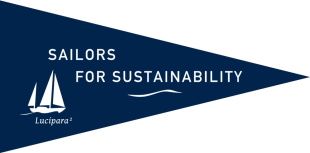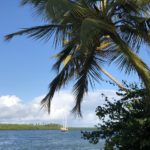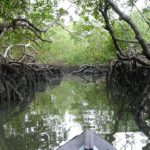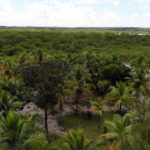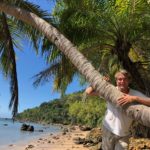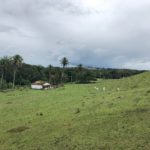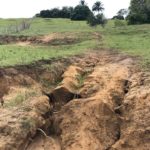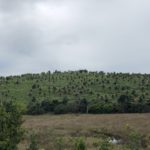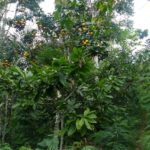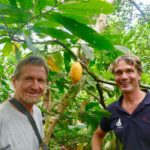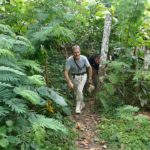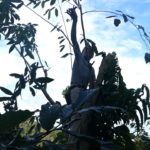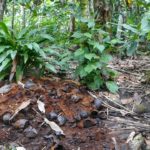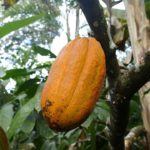Food Forests (BRA)
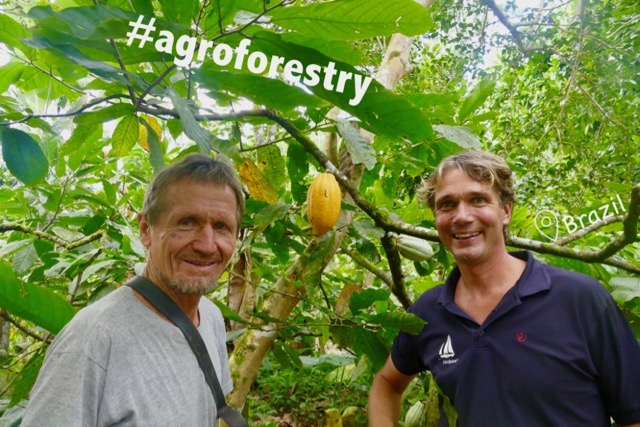
In Brazil, Ernst Götsch explains to us how to grow healthy food in cooperation with the forest, an inspiring solution for the widespread deforestation.
Contributes to achieving the following UN Sustainable Development Goals:
“Wow, it’s so green!” Floris exclaims. We have just sailed more than 2,000 nautical miles across the Atlantic Ocean, so arriving in tropical Brazil makes us happy. After three weeks of seeing only blue around us, we are ready for a different colour and eager to explore a new country. We drop anchor at a densely wooded island in a bay near Salvador. Thousands of mangroves grow on the border of land and sea, their roots in the seawater. Coconut palms stand tall on sandy beaches. Behind them all kinds of trees and plants occupy every square centimetre. “That’s not surprising, considering it’s an ideal climate for plant growth with temperatures of around 30°C all year round, lots of sun and tropical showers”, Ivar notes.
Deforestation Everywhere
Thanks to the country’s favourable climate and huge size – Brazil is over 200 times the size of the Netherlands – it is easy to understand why agriculture is an important economic activity. Nevertheless, when we look into the extent of the deforestation linked to agriculture, we find the results shocking. Around 90% of the original Atlantic rainforest has been cut down. Livestock farming and the cultivation of animal feed such as soy are the main causes of deforestation. In addition, rainforest is destroyed for the cultivation of food crops as monocultures. On our expeditions along the coast and into Brazil’s interior we see a lot of monocrop plantations, animal husbandry and soil erosion resulting therefrom.
Despite the global focus on forest conservation, deforestation in Brazil has even been increasing recently, especially in the Amazon. The disappearance of the original forest has had major negative consequences for the indigenous inhabitants, the biodiversity, the soil and the climate. Looking forward, scientists are increasingly worried that deforestation in combination with climate breakdown will lead to droughts, wildfires and irreveversible loss of the Earth’s largest rainforest. Is there no better way to grow food, we wonder?
Fulfilling Our Task in the Ecosystem
“Of course there is!” Ernst Götsch says, solemnly. The Swiss came to the Brazilian state of Bahía in the 1980s and started a food forest. His method has since become a model for how you can grow food in harmony with nature. We couldn’t have found a better person and place to find an answer to our question.
During our visit, Ernst talks extensively about the philosophy behind the food forest. “Nature has evolved over billions of years into a perfect, balanced ecosystem”, he begins. “To have enough food, we have to fulfil our task in the ecosystem. That is to spread seeds and stimulate plant growth.” An extensive lesson follows about evolution, the role of humans and animals, biology, and the climate. “All animals and plants have a function. That is why there are no such thing as ‘weeds’ in a balanced ecosystem”, Ernst assures us. His method starkly contrasts with industrial agriculture, in which rainforests are destroyed, unwanted plants are eliminated, insects are killed and synthetic fertilizers are used.
Agriculture in 3D
It becomes clear to us that Ernst’s method has a strong theoretical basis. But what does it mean in practice? “I will give you a tour of my farm and you will see for yourself”, Ernst suggests. His land looks more like a forest than a farm. “When I started here thirty years ago, the land was dry and barren. That was the result of the typical approach that leads to deforestation.” Ernst explains that the rainforest was felled for the most valuable wood, after which the remaining vegetation was burnt. Subsequently, monoculture crops were planted that completely depleted the topsoil. “There was also much less rain because the trees were gone, “, Ernst continues. How did he restore nature?
“I started to plant, hundreds of bushes, plants and trees per year.” Ernst points to the trees. “Just like nature, I use the third dimension: the height. That’s why you see different layers of vegetation. The tall trees are mahogany trees. They produce beautiful wood. In between I planted the fruit trees. And underneath grow cocoa trees, which need shade.” We look around carefully and recognize a pattern. Fruit trees such as orange, lemon, papaya and banana surround every towering mahogany tree. Countless cocoa trees grow under the fruit trees. Closer to the ground grow corn and vegetables such as fennel, ginger root and cassava, a native root.
We not only notice the amount of different trees and crops, but also the many insects and birds. “To further increase the biodiversity in the ecosystem, I also planted many native trees and plants that do not bear edible fruits.” It has transformed his land into a true jungle. “Thanks to the many trees, rainfall significantly increased, helping other plants and allowing the insects and birds to come back. For example, there are now 30 species of hummingbirds living here”, says Ernst proudly.
Healthy Quality and Higher Yields
“I cooperate with nature. All those different plants and animals play an important role and keep the ecosystem in balance. That’s why the plants are healthy and I don’t need to use any agricultural poison or externally produced fertilizer.” Even the infamous ‘witch’s broom fungus’, that has devastated cocoa cultivation throughout Bahía, is under control at Ernst’s farm. “Healthy trees carry healthy cocoa beans”, he smiles. “And of excellent quality!”
As if Ernst can read our thoughts, he continues to talk about the yield of his farm. “If you add up the harvests of all the different crops, my method provides more nutritional value per square meter than monoculture farming does. Moreover, I don’t have to spend money on agricultural poisons and synthetic fertilizer because I only use pruned branches and leaves as fertilizer. Nature does the rest!”
Pruning to Fertilize the Soil
In addition to maximizing biodiversity, pruning is another important key factor for the success of the food forest. “Pruning is crucial to fertilize soils”, Ernst explains. He takes a chainsaw and cuts an impressive amount of branches from a tree. “After pruning, I leave the branches with leaves on the ground. That way, the soil is enriched with nutrients. The pruned trees grow quickly again, making the whole forest much more productive.” As an additional benefit the trees extract additional CO2 from the air, convert it into carbon and store it in their biomass and in the soil. A healthy, carbon-rich soil can retain much more moisture. And that is crucial to stimulate plant growth and prevent erosion.
“Pruning is a lot of work, but I can still handle it on my own. And if you take the local circumstances into account, my method can be used anywhere,” Ernst says. He even finds the time to travel around the world to explain his method.
A Cure for Many Ailments
Ernst’s food forest is a shining example of sustainable agriculture. We find it remarkable that he started on a deforested, barren piece of land that was once covered by rainforest and subsequently destroyed by conventional industrial farming methods. Thanks to the many bushes, plants and trees that Ernst planted, rainfall and biodiversity increased. The ecosystem was able to recover, and Ernst can harvest healthy fruits and vegetables. “He even has better yields per square meter than industrial monoculture farming!” Ivar says enthusiastically. “And his method is so much better for biodiversity and the climate. Shouldn’t Ernst’s methods be applied everywhere?!” Food forests: Truly a cure for many ailments.
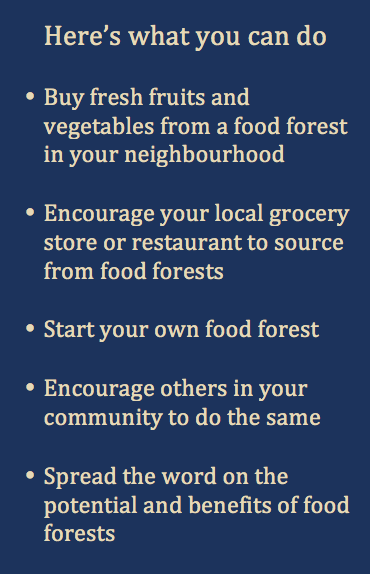
Related Sustainable Solutions

Smart with Seaweed (NZL)
In New Zealand we learn how seaweed can be used to improve soil biology, with significant environmental and economic benefits for all farm types.

Urban Gardening (NZL)
In New Zealand’s cities we discover various ways of urban gardening and learn about the many benefits of growing food in cities.

Improving Children's Health with Veggies (PER)
High in the Peruvian Andes, poor school children learn how to grow and cook healthy, organic veggies. An example for the world?

Meatless in Buenos Aires (ARG)
In the beef capital of the world, the tide is turning in favour of plant-based diets. Good news for human health, animals, nature, and the climate.

Alda's Organic Neighbourhood Farm (URY)
Organic farmer Alda explains how fertile soil enables her to grow food without poison, increases biodiversity, and has positive climate effects.

Natural Coffee (BRA)
We visit a coffee forest in Brazil and learn all about the environmental and social benefits of agro-ecology.

Food Forests (BRA)
In Brazil, Ernst Götsch explains to us how to grow healthy food in cooperation with the forest.

Bananalogic (ESP)
On the Canary Island of La Palma in Spain, we discover that the logical way to grow bananas is with butterflies instead of poison.

Olive Oil (GRC)
In Greece we take a closer look at olive oil, which is an integral part of Greek history and culture. We discover ways of growing olives sustainably.

Slow Food (ITA)
The Slow Food movement promotes food that is good for the consumer, good for the producer, and good for the planet.
